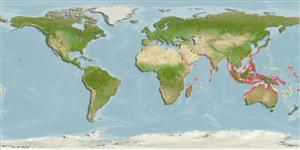Common names from other countries
>
Gobiiformes (Gobies) >
Gobiidae (Gobies) > Gobiinae
Etymology: Glossogobius: Greek, glossa = tongue + Latin, gobius = gudgeon (Ref. 45335).
More on author: Hamilton.
Environment: milieu / climate zone / depth range / distribution range
Ecología
marino; agua dulce; salobre bentopelágico; anfidromo (Ref. 51243); rango de profundidad 0 - 5 m (Ref. 86942). Tropical; 25°C - ? (Ref. 2059); 30°N - 32°S, 25°E - 176°E
Africa to Oceania: Red Sea and East Africa, south to Transkei in South Africa, and most inland freshwater bodies over the Indian Ocean and western Pacific (Ref. 4343, 52193). Common in coastal and estuarine waters from austral Africa and Madagascar to India and south of China.
Length at first maturity / Tamaño / Peso / Age
Maturity: Lm ?, range 9 - ? cm
Max length : 50.0 cm SL macho / no sexado; (Ref. 4967); common length : 11.3 cm SL macho / no sexado; (Ref. 35840)
Espinas dorsales (total) : 7; Radios blandos dorsales (total) : 8 - 9; Espinas anales: 1; Radios blandos anales: 8 - 9.
Found mainly in freshwater and estuaries, but also enter the sea (Ref. 4833). Also occur in canals, ditches and ponds (Ref. 12693). Found in clear to turbid streams with rock, gravel or sand bottoms (Ref. 2847). Encountered in medium to large-sized rivers of the lower Mekong (Ref. 12975). Feed on small insects, crustaceans and small fish. Grow to a much larger size in brackish water than in fresh water. Marketed fresh (Ref. 12693). Cannibalism is relatively common for this species (Ref. 48660).
Spawning occurs in freshwater afterwhich eggs and larvae are washed down by the river current into the sea (Ref. 110258).
Maugé, L.A., 1986. Gobiidae. p. 358-388. In J. Daget, J.-P. Gosse and D.F.E. Thys van den Audenaerde (eds.) Check-list of the freshwater fishes of Africa (CLOFFA). ISNB, Brussels; MRAC, Tervuren; and ORSTOM, Paris. Vol. 2. (Ref. 4343)
IUCN Red List Status (Ref. 130435)
CITES (Ref. 128078)
Not Evaluated
Threat to humans
Harmless
Human uses
Pesquerías: escaso valor comercial; Acuicultura: comercial; Acuario: Comercial
Herramientas
Special reports
Download XML
Fuentes de Internet
Estimates based on models
Preferred temperature (Ref.
115969): 25 - 29.3, mean 28.5 (based on 2836 cells).
Phylogenetic diversity index (Ref.
82804): PD
50 = 0.5000 [Uniqueness, from 0.5 = low to 2.0 = high].
Bayesian length-weight: a=0.00724 (0.00642 - 0.00818), b=3.07 (3.04 - 3.10), in cm Total Length, based on LWR estimates for this species (Ref.
93245).
Nivel trófico (Ref.
69278): 3.7 ±0.2 se; based on diet studies.
Resiliencia (Ref.
120179): Alto, población duplicada en un tiempo mínimo inferior a 15 meses (K=0.8; Fec=18,578;).
Fishing Vulnerability (Ref.
59153): Low to moderate vulnerability (26 of 100).
